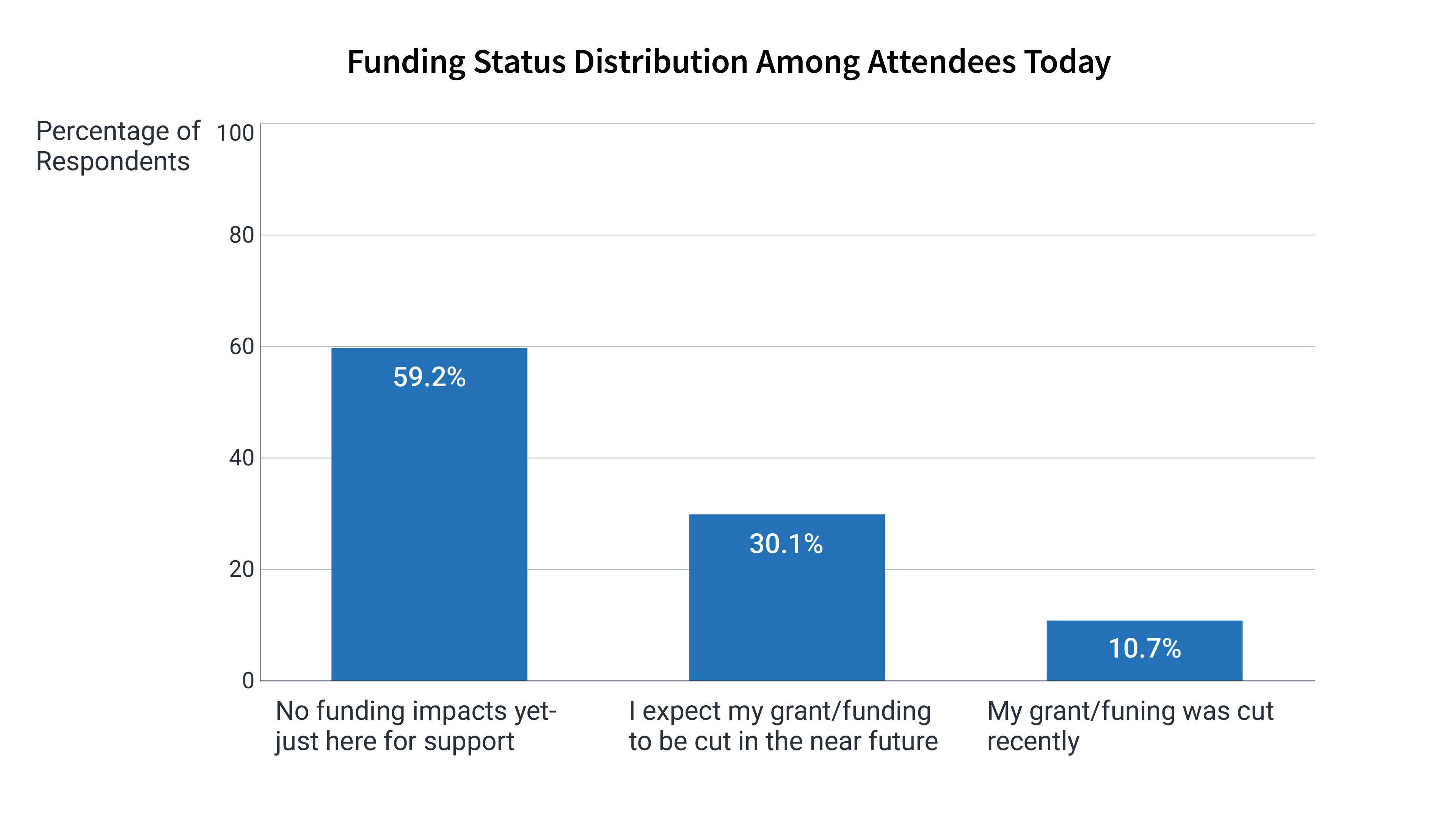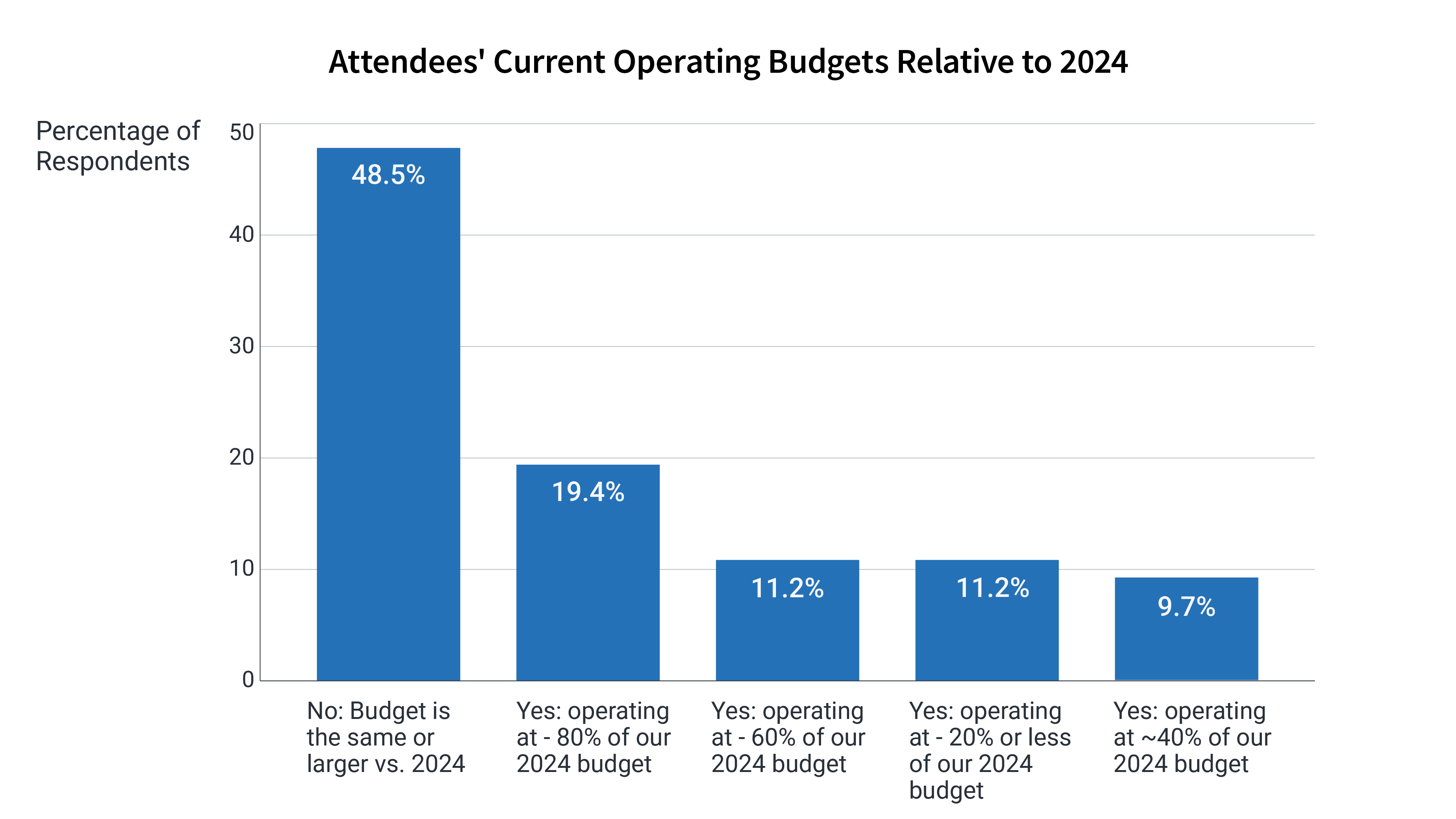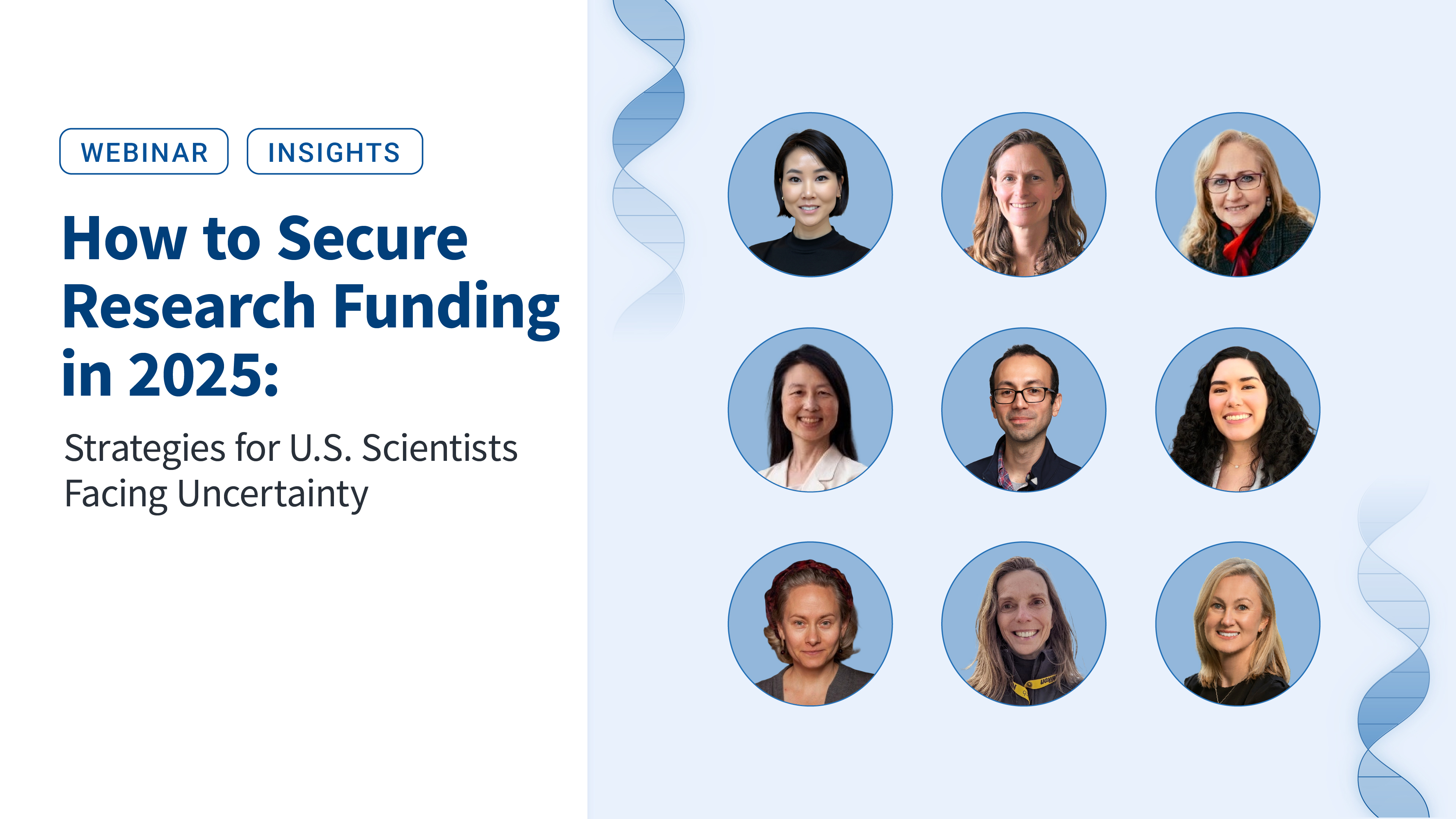10 Key Insights & Strategies for U.S. Scientists Facing Uncertainty
With federal budget threats looming and agency priorities shifting, U.S. researchers are navigating a new era of uncertainty. BioRender’s 2025 State of Science Funding Report, based on insights from over 300 researchers across 100+ institutions, revealed the depth of concern and how scientists are adapting.
To shed light on the path ahead, we brought together a panel of early-career researchers, institutional leaders, federal advisors, and grant strategists. The conversation was candid, timely, and ultimately hopeful: the challenges are significant, but so are the strategies for navigating them.
We’ve distilled the top 10 takeaways from the discussion, rooted in direct quotes from the panelists. Whether you’re seeking clarity, reassurance, or a path forward, here’s what you need to know now.
1. The State of U.S. Science Funding in 2025
Since 1945, when Vannevar Bush’s Endless Frontier laid the foundation for federally funded research, agencies like NIH and NSF have reliably supported science, but this long-standing framework is now being tested.
"I was anticipating a worst-case scenario where the federal government completely pulls out of supporting research in academia," said Dr. Jeanette Wing, Executive Vice President for Research at Columbia University, " I'm not saying it's that we're headed there, but we are certainly having conversations on various campuses in terms of what-if scenarios."
She’s not alone. According to BioRender’s 2025 State of Science Funding Report, 87% of PIs say their labs are already experiencing, or expect to face, serious financial strain, and 80% of research administrators anticipate reducing headcount within the year.
While institutions remain in a holding pattern, the uncertainty is already reshaping how and whether scientists continue their work.
2. Federal Funding Uncertainty Is Reshaping Research Careers
The ripple effects of federal funding uncertainty are already disrupting labs and career paths, especially for early-career scientists.
"As a postdoc, you’re supposed to be couched in this sort of trainee position," said Dr. Josie McGowan of Harvard Medical School. "But I came in with funding that is teetering on the edge of being taken. I’ve had to think about leaving academia, leaving my postdoc early [...] It shifted the focus entirely from the science… into contingency plans."
McGowan’s story reflects a growing concern in the research community: that systemic uncertainty, not just policy, is pushing a generation of researchers to rethink their future in science. According to BioRender’s 2025 State of Science Funding Report, 57% of researchers say they are now considering leaving U.S. academia altogether.
Many are spending more time writing grants than doing research. The report found researchers now spend an average of 40% of their time on grant-related activities, a burden that leaves less time for discovery and innovation.
Dr. Alex Chavez, Associate Professor at UC San Diego, emphasized that the disruption has long-term implications for the scientific pipeline itself.
"Instead of people focusing on what really matters - data, pushing forward the knowledge frontier – they’re just worried about this," he said. "MD-PhD programs are admitting 50% fewer students. That’s a 14-year pipeline being cut. Even if funding returns, it’ll take years to recover."
This contraction in the training pipeline won’t just stall academic labs, it threatens the entire ecosystem of scientific innovation. "We’re worried about where the creative ideas are going to come from," industry and biotech leaders have told Dr. Jo Handelsman. "Three years down the road, there’s going to be nothing for us to commercialize."
With graduate cohorts shrinking by half in some programs, the concern is significant for the next wave of innovation as well as the future biotech workforce itself. Handelsman called on industry leaders to speak out: "This is a time when people have to be courageous and speak out, especially when it’s about science, something that benefits society so broadly."
3. Perception vs. Policy: What’s Actually Driving Researchers' Anxiety?
While concern across the research community is warranted, panelists emphasized an important distinction: it’s the uncertainty rather than actual funding cuts that’s driving most of the anxiety.
"The actual cuts have not really taken place yet," said Dr. Jo Handelsman, Director of the Wisconsin Institute for Discovery and former Associate Director for Science at the White House Office of Science and Technology Policy, "I just hope people don’t leave science based on a false impression of where we are in the funding situation."
Handelsman acknowledged the political instability, but pointed to promising signs worth tracking: proposed flat budgets for NIH and NSF from the Senate, advancing USDA research funds, and a court ruling reinstating several NIH grants. These indicators point to a funding landscape that’s evolving but not collapsing.
But perception is proving just as disruptive as reality. According to BioRender’s 2025 State of Science Funding Report:
- 90% of researchers believe federal budget cuts will hinder research progress
- 80% expect budgets to decline by an average of 20% in the next 12–18 months
- Meanwhile, three-quarters of research administrators report low faculty morale
Handelsman encouraged researchers to stay focused and informed. Premature career moves, she warned, may be based more on perception than reality, which could result in missed opportunities as funding conditions stabilize.
Our live attendee polls echoed this disconnect: 30% of participants said they were preparing for budget reductions, despite the majority not having experienced major impacts so far.


4. Why Scientists Must Be Advocates in 2025
In the face of the uncertainty, however, researchers don’t have to remain passive. The panelists emphasized that advocacy doesn’t have to begin in Washington D.C., it begins in classrooms, lab meetings, and everyday conversations.
"Four years sounds like a really long time. And it is," said Dr. Jo Handelsman, Director of the Wisconsin Institute for Discovery, "but remember we have a Congress that changes - the House every two years, the Senate every six. There’s a midterm coming up that could completely change the nature of science funding."
While long-term forecasts remain unclear, the message was clear: don’t make short-term decisions out of fear. Instead, focus on what you can control.
Dr. Alex Chavez, a self-described introvert, shared: “Real scientists think the data speaks for itself, but even I reached out to my congressman… This is the job now. I just try to control what I can.”
For postdoc Dr. Josie McGowan, that means pouring energy into the day-to-day impact she can have. "I’ve channeled a lot of that stress into mentoring," she said. "That’s where I can make a difference right now."
From mentoring students to speaking up on local committees, advocacy starts with a simple goal: keeping science visible, valued, and ensuring people understand its impact.
5. Becoming Better Science Communicators is the Key to Regaining Public Support
Advocating for the "why" behind the science is especially relevant as panelists pointed to a quieter but equally urgent challenge: the erosion of public trust in science.
"We have to realize that we’ve lost some trust in science by the public," said Dr. Jeanette Wing, Executive Vice President for Research at Columbia University. "And it is partly up to us, as scientists, to help change that."
That work starts with how science is communicated. Researchers must go beyond the data to help people understand how science has made a positive impact. As Dr. Wing puts it, "Most people don’t know what research is…don’t understand how science operates…so it is up to us to help with that translation."
"We all need to be more proactive about getting out there and telling our stories," said Dr. Jo Handelsman. "Especially graduate students need to convince the public that what we do is worthwhile."
At BioRender, we believe that clear, accessible communication is fundamental to scientific progress. It’s why we’re helping researchers translate complex ideas into visual stories that resonate, whether with funders, collaborators, or the public. Science doesn’t speak for itself. Scientists have to tell their story clearly and powerfully.
6. New Sources of Support: How Philanthropy Is Filling the Gap
As federal budgets remain uncertain, philanthropy is emerging as a critical source of research support.
"Philanthropy is not positioned to replace government funding," said Emily Baxi, Director of SPARC at the Milken Institute. "But it is very good at bridging gaps, responding with agility, and assuming a certain level of risk."
She noted that philanthropy now contributes nearly $30 billion to research annually, accounting for an estimated 44% of total U.S. research funding. With greater flexibility and a higher tolerance for risk, it’s becoming a vital complement to federal sources.
According to BioRender’s 2025 State of Science Funding Report, 86% of principal investigators and research administrators are actively exploring non-federal funding, including partnerships with philanthropic foundations and the pharmaceutical industry.
Baxi’s advice for researchers was clear: Don’t wait until you’re in a funding crisis. Start identifying funders aligned with your area of research now, learn their missions, and begin building relationships early, "there’s a lot scientists can do right now to position themselves for success."
7. How to Write a Fundable Grant Proposal in 2025
In today’s crowded and competitive funding environment, clarity in your funding applications isn’t just a bonus but a requirement.
"The first thing is, can I skim it?" said Dr. Angela Andersen, a grant advisor who works closely with researchers. "Grants can be incredibly dense. What’s important is - can I find the hypothesis and the gap?"
Dr. Andersen advised that to stand out, proposals need to be as strategically structured as they are scientifically sound. Start with your aims and build from there. Highlight your hypothesis, your unique solution, and why you're the one to tackle it.
And don’t overlook the fundamentals:
- Rigor and reproducibility
- Clear experimental design
- Transparent discussion of potential pitfalls
Both Dr. Angela Andersen and Dr. Ann Schlesinger, Director in Early Strategic Partnerships at Novartis, underscored that successful proposals highlight collaboration. Today’s most compelling grants often feature cross-disciplinary and inter-disciplinary collaborations along with a variety of approaches to solving a problem. Funders aren’t just evaluating individual ideas, they’re looking for networks of expertise capable of driving real impact.
8. Funding Networks Matter: Why Strong Relationships Help Win Grants
In today’s funding environment, great science isn’t enough. Behind most successful proposals is a well-developed network of mentors, collaborators, advisors, and funders.
Dr. Emily Baxi emphasized that philanthropic funders are looking to build communities. "We want to bring investigators together so they can exchange ideas, support one another, and move the field forward before and after the grant."
That spirit of connection extends beyond funders. Dr. Angela Andersen reinforced the vitality of peer support during the writing process itself. She emphasized that writing grants can feel demoralizing and intimidating, so having a group to stay accountable to and get feedback from is essential.
Dr. Ann Schlesinger further explained the importance of building a network in industry as well:
"This interdisciplinary nature is becoming more important. Not just in academia, but in industry and foundations, too. We’re no longer looking for a single expertise. We’re looking for teams that bring orthogonal ideas together to really advance a field."
She encouraged scientists to be bold about outreach, using tools like LinkedIn as a place to start building your network.
Whether you’re applying for funding or simply shaping a research idea, build your ecosystem early. Tap into university resources, join writing groups, start conversations with mentors, collaborators, or funders, because those early conversations can lead to opportunities long before you submit.
9. Science Is Still the Best Job in the World
Even in the face of funding uncertainty, the panelists closed with something deeper than policy: a reaffirmation of purpose rooted in the enduring nature of discovery.
"Humans are curious," said Dr. Jeanette Wing. "They want to solve problems. They want to address big-vision questions. Whatever the funding situation, they’re going to want to do what we call research."
Others echoed that same spirit. Dr. Alex Chavez emphasized that while priorities may shift, the universe remains governed by a single truth, and science will ultimately bring that to light.
For Dr. Josie McGowan, the drive to teach and discover is itself a form of resistance against the current climate. "They’re not going to take that away from me," she shared. She also offered a personal recommendation: "Everyone should go read Katalin Karikó’s Breaking Through. That really helped me frame this time in science and how to get through it."
Despite these pressures, most leaders are choosing to stay and keep fighting for science. As BioRender’s 2025 State of Science Funding Report found, only 13% of senior research leaders are considering leaving academia or relocating, a sign of resilience even in difficult times.
And in closing, Dr. Jo Handelsman offered a powerful reminder of what keeps researchers going: "science is fantastic. Being an academic scientist or industrial scientist is the best job in the world."
The future of science may be uncertain, but its mission endures. Discovery doesn’t stop because the passion and resilience of researchers continue to carry it forward.
10. Supporting the Path Forward: BioRender’s Grant Support Initiative
These key takeaways make one thing clear: navigating today’s funding landscape requires more than great science. It takes clear communication, a collaborative network, and the confidence to advocate for your work.
That’s why BioRender has launched the Grant Support Initiative: to help researchers sharpen their proposals and stand out in a competitive review environment. From expert-led figure design to grant editing and coaching, we’re offering nearly $200K in support to help researchers like you strengthen your next submission.
Dive Into the Full Conversation
Watch the full panel discussion for uncut insights from academic leaders, funders, and grant advisors, plus tips on designing better grant figures and details on BioRender’s Grant Support Initiative. View the full recording here:
By Anneli Dey, Content Marketing Specialist
Wed Jul, 30 2025


.png)





